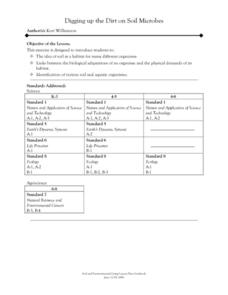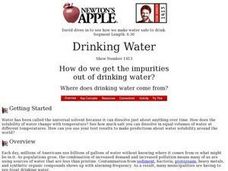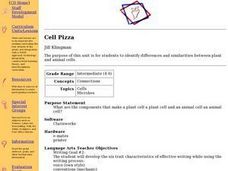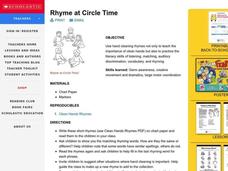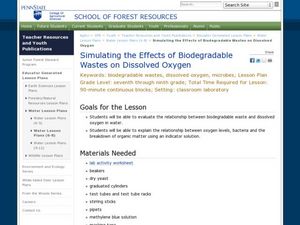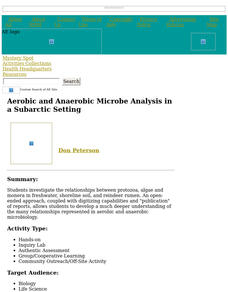Baylor College
Comparing Sizes of Microorganisms
Kids compare what printed text looks like with the naked eye and under magnification. They discuss the extremely small scale that must be used to measure the size. They learn about the micrometer unit, then draw scale models of a variety...
Curated OER
Life Traps - Lesson Plan
Students observe and discuss microbes. In this microbes lesson students complete a lab activity where they grow microbes in petri dishes and discuss their findings.
Curated OER
Dirt Life
Students select and collect soil samples from a variety of locations (schoolyard, home, etc.). They do this lab after an interest-generating discussion about "dirt" and microbes. Students make a dilution in sterile water, plate it on a...
Curated OER
Classify the Microbes
Students classify microorganisms into categories based on their characteristics. Pupils use a taxonomic key to identify organisms. They classify certain bacteria, protists, and viruses using a classification or taxonmic key.
Curated OER
Microbe Power - Using a Winogradsky Column as a Battery
In this lesson the student demonstrate analysis of the changes taking place in the bottle as well as bdemonstrate application of the interactions happening in the bottle by applying these changes to the environment.y measuring and...
Curated OER
The Science of Microbes
Students will explore cells to understand that all living things are composed of cells. In this science lesson, students use the scientific process and work in cooperative groups to gain a better...
Curated OER
Digging up the Dirt on Soil Microbes
Students are introduced to the idea of soil as a habitat for many different organisms. They are introduced to the links between the biological adaptations of an organism and the physical demands of its habitat. Pupils are introduced to...
Curated OER
Bacterial growth
Students explore the exponential growth and decay of microbial populations in relation to the organism tolerance ranges in their environment, They observe the impact of changing variables which can affect microbial populations.
Curated OER
Watch Germs Spread
Students demonstrate how germs spread from one person to another. They hide a small quantity of flour or cornstarch in their hand and then pretend to sneeze or cough into the hand. they shake hands with a child sitting nearby. They...
Curated OER
Using Mathematics to Explain the Spread of Diseases
Young scholars use statistics to solve problems based on the spread of disease. In this disease lesson students study the role that viruses and bacteria play in the spread of diseases and explain pandemics.
Curated OER
Microbes and Health
Students participate in activities that show them how tiny germs are spread. In this germs lesson plan, students engage in hands on lessons to show them how microorganisms can easily spread disease through the mouth and hands.
American Society for Microbiology
”Build a Bacterium” Scavenger Hunt
An exciting activity has scholars use cell parts to build bacteria through cooperation with other groups. Each group has some of the cell parts needed, but they must trade with other groups to be able to fulfill their function as a...
Bonneville
Bioreactor Water Circulation System
Make those microbes warm up water. Pupils first investigate water pumps, then design a water circulation system that uses solar energy. A bioreactor in the system takes energy from compost and helps heat water.
Curated OER
A Virtual Visit to the Microbial Zoo
Young scholars complete a WebQuest on viruses, bacteria, and protists. They explore various websites, and answer discussion questions.
Curated OER
Is There Life Before 121?
Students observe microbial growth in the lab. In this biology lesson plan, students determine the conditions suitable for bacterial growth. They explain the methods of sterilization and bioburden testing.
Curated OER
Still Waters
Students construct a still to turn seawater into drinking water. They estimate the cost of distilling it. They investigate ways to make the conversion more efficient. They track the source of their home drinking water and make a map of...
Curated OER
Cell Pizza
Students identify parts and functions of microscope. Students watch video, Cells and Life about cell parts with actual pictures and actual cells. Students discuss video and identify parts of the cells that animals and plants have in...
Curated OER
Winogradsky in a Bottle: Beginning a Winogradsky Column
Students use their measurement skills by marking a bottle for construction purposes. They record qualitative and quantitative data and analyze their results. Students demonstrate evaluation of a small scale systems as a model for the...
Curated OER
Tag the Germs
Students review what happens when they wipe germs off their hands with a wet wipe. Next, they play a game of tag in which some students are germs and others are wipes. They move around while music plays, stop when it stops, and the wipes...
Curated OER
Count on Wet Ones??
Students listen to fingerplay songs, clean hands with Wet Ones wipe or squirt of hand sanitizer, sing Five Little Monkeys Jumping on the Bed, discuss what would happen if monkeys were germs on their hands, and use their hands and...
Curated OER
Rhyme at Circle Time
Students study the importance of clean hands and practice the literacy skills of listening, matching, auditory discrimination, vocabulary, and rhyming. They illustrate their rhyme chart with drawings or photos taken doing the different...
Curated OER
Simulating the Effects of Biodegradable Wastes on Dissolved Oxygen
Students evaluate the relationship between biodegradable waste and dissolved oxygen in water. In this biodegradable wastes instructional activity students complete a lab activity in groups then analyze their results.
Curated OER
Aerobic and Anaerobic Microbe Analysis in a Subarctic Setting
Learners investigate the relationships between protozoa, algae and monera in freshwater, shoreline soil, and reindeer rumen. They publish reports of their findings.
Curated OER
On the Microbe Trail: An Introduction to Bacteria and Aseptic Technique
Tenth graders predict the conditions necessary for bacterial growth, test their predictions and at the same time practice the aseptic techniques and safety procedures needed when working with bacteria.
Other popular searches
- Microbes and Public Health
- Microbes and Disease
- Agar Plates Microbes
- Beneficial Microbes
- Growing Microbes
- Identifying Microbes
- Science Microbes
- Microscopic Microbes
- Microbes Disease
- Microbes in Food
- Germs and Microbes
- Microbes in Food Processing






